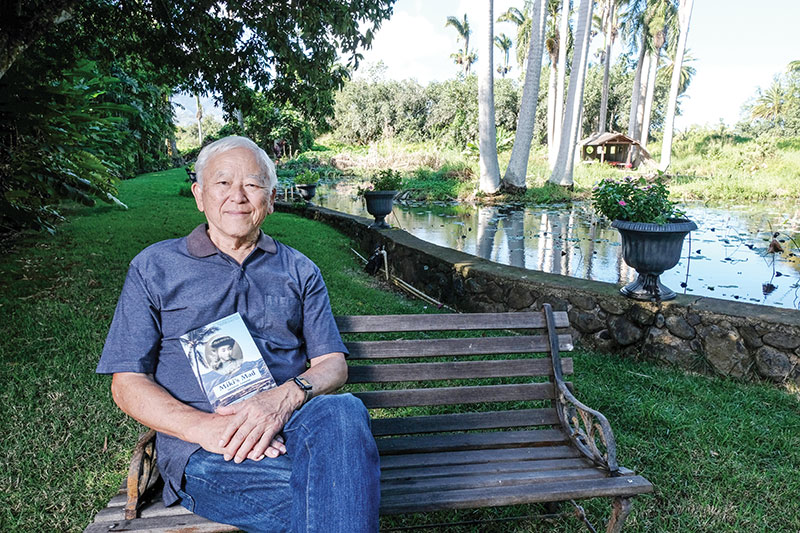One Man’s Treasure

George Tanabe has accomplished a lot over the years as a religious scholar, community leader and devoted storyteller. In the coming days, he’ll receive his latest honor as one of Honpa Hongwanji Mission of Hawai‘i’s Living Treasures. Photo by Lawrence Tabudlo
Each year, Living Treasures of Hawai‘i recognizes individuals who demonstrate excellence in their respective fields and whose contributions enrich society.
This description certainly applies to George Tanabe, a distinguished scholar and noted leader in the community. Tanabe will be among those honored at this year’s Living Treasures of Hawai‘i ceremony, hosted by Honpa Hongwanji Mission of Hawai‘i and scheduled for Feb. 8. Others who will be recognized are Bill Char, Victoria Holt Takamine, Neil Hannahs and Dennis Agena. (See accompanying story on page 13.)
Established in 1976, Living Treasures of Hawai‘i was initially created to honor those involved in the perpetuation of the island’s distinctive artistic and cultural heritage. It’s since been expanded to include contributions by individuals in all areas.
“It’s a great honor,” Tanabe says. “Some of these people are really accomplished leaders in the Hawaiian community and it’s a great honor to be recognized at their level.”
Born and raised in Waialua, Tanabe attended Waialua High & Intermediate School through the 11th grade before transferring to University High School for his senior year. He cites his final year of high school as the point in which his views on academics changed, adding that is also when his passion for reading, writing and storytelling began.
While Tanabe is a Waialua boy at heart, he chose to leave the islands to expand his education. He enrolled at Willamette University in Oregon and majored in history. Afterward, he matriculated at Union Theological Seminary in New York, where he received his master of divinity.
Finally, Tanabe attended Columbia University, where he earned his master’s and doctorate in East Asian Studies. He later moved to Japan for a couple years to study and research the country’s religions, particularly Buddhism.
As a religious scholar, Tanabe served as a professor at University of Hawai‘i at Mānoa for nearly 30 years. He is also the former chair of its religion department.
Tanabe also played a pivotal role in Japanese-American relations in the aftermath of the Ehime Maru and USS Greeneville disaster in 2001.
The incident made headlines as a U.S. Navy submarine collided with a Japanese fishing vessel off O‘ahu, claiming the lives of multiple people, including a number of Japanese high school students. Following the event, Tanabe was brought in as a consultant to help the U.S. Navy recover the remains. His expertise in Buddhism was especially beneficial in appropriately pulling the bodies — which had already been in deep waters for some time and had begun to decompose — from the sea.
“From the standpoint of Buddhist belief, it’s extremely important to have the remains of the dead so that they can be properly buried and cared for,” Tanabe explains. “In Japan, the deceased are mostly cremated, and then the family goes to the crematorium and then they take the bones, and they put the bones in the urn.
“There’s a very specific order in which you take the bones,” he continues. “You always start with the feet — you work your way up. The last thing that goes into the urn is the skull.”
Following Tanabe’s instructions, divers retrieved the body parts in a similar fashion, and the recovery mission was deemed a success.
For his assistance in the mission and his contributions in strengthening the academic and cultural exchanges between the U.S. and Japan, Tanabe received two honors: the Japanese Foreign Minister’s award and the Imperial Order of the Rising Sun award.
“It was a great honor, but it was a sobering honor,” Tanabe says. “Nevertheless, I was happy that we were able to complete the recovery project to the satisfaction — that was the main thing — to the satisfaction of the families and the Japanese government.”
Although Tanabe is retired, he continues to promote Buddhist teachings and cultural heritage as the president of both Bukkyo Dendo Kyokai America and BDK Hawai‘i. The organizations aim to promote greater understanding of Buddhist wisdom by sponsoring activities and programs.
One of the main things BDK does is distribute books about Buddhism. According to Tanabe, 10 million copies of The Teachings of Buddha have been distributed across 60 different countries.
“Buddhism is known for, you know, looking into yourself, getting to know yourself better,” Tanabe shares. “Being able to not worry about things so much, to reduce your stress, to have a calm state of mind. And I think this is what might be appealing to people.”
Tanabe’s academic works have been published by university presses of Harvard, Princeton and Columbia. But these days, Tanabe has been focusing on writing fiction.
“Fiction is a really powerful way to tell truths, which is why all religions and all of their scriptures are filled with stories that are not scientifically, or rationally, or historically true, but they tell truths,” he says. “They tell us something true about life. It’s actually very much related to what I did during my whole professional career. And it made me realize that my whole career and my post-teaching career, that what I have been doing is telling stories.”
Whether he is teaching religious stories as a professor, writing fiction novels during his free time or reading stories to his grandson, Tanabe came to the realization that he’s always been a storyteller.
“The one sort of theme that runs through my whole life is storytelling,” Tanabe shares. “That’s what I’ve been doing. I’ve been reading, writing and telling stories. So in that way, writing fiction now is kind of a continuation of what I’ve always done, pretty much, you know, all my life.”
Tanabe has written four fiction books so far. His first published novel, Miki’s Mad, is set in 1900 Hawai‘i and tells the story of a Japanese immigrant at a sugar plantation. Miki’s Mad, which captured third place at a Hawai‘i Writers Conference, is available on Amazon.
So Much More To Treasure
Aside from George Tanabe, four other honorees will be recognized when the 50th Living Treasures of Hawai‘i Recognition Program and Luncheon at noon on Feb. 8 in the Hilton Hawaiian Village Waikīkī Beach Resort’s Coral Ballroom.
Bill Char has dedicated his time as a cultural steward and master lei-maker for the past five decades. He has been revitalizing and innovating the traditional Hawaiian art of lei-making by blending ancestral wisdom with modern artistry. Known for his dedication and humility, Char has mentored numerous students and elevated the cultural significance of lei-making in Hawai‘i and beyond.
Victoria Holt Takamine is a cultural advocate, kumu hula and mentor. Motivated by a deep love of the Hawaiian people and culture, she advocates for cultural preservation, social justice and environmental stewardship with organizations like the Pa‘i Foundation and for projects such as Ola Ka ‘Ilima, an affordable housing and workspace for artists in Kaka‘ako.
Neil Hannahs is a leader in cultural and natural resource stewardship, acclaimed for his approach to ‘āina-based education and sustainable land management across Hawai‘i. His work as founder of Ho‘okele Strategies and the First Nations Futures Project fosters indigenous leadership and aims to preserve the Hawaiian culture as well as environmental stability.
Dennis Agena has spent decades mentoring thousands of young athletes, teaching them basketball fundamentals as well as life lessons in teamwork, respect and integrity. As founder of the Kalākaua Basketball Clinic in Kalihi, Agena is renowned for his dedication and his influence extends beyond the basketball court, inspiring countless youth to pursue higher education.


